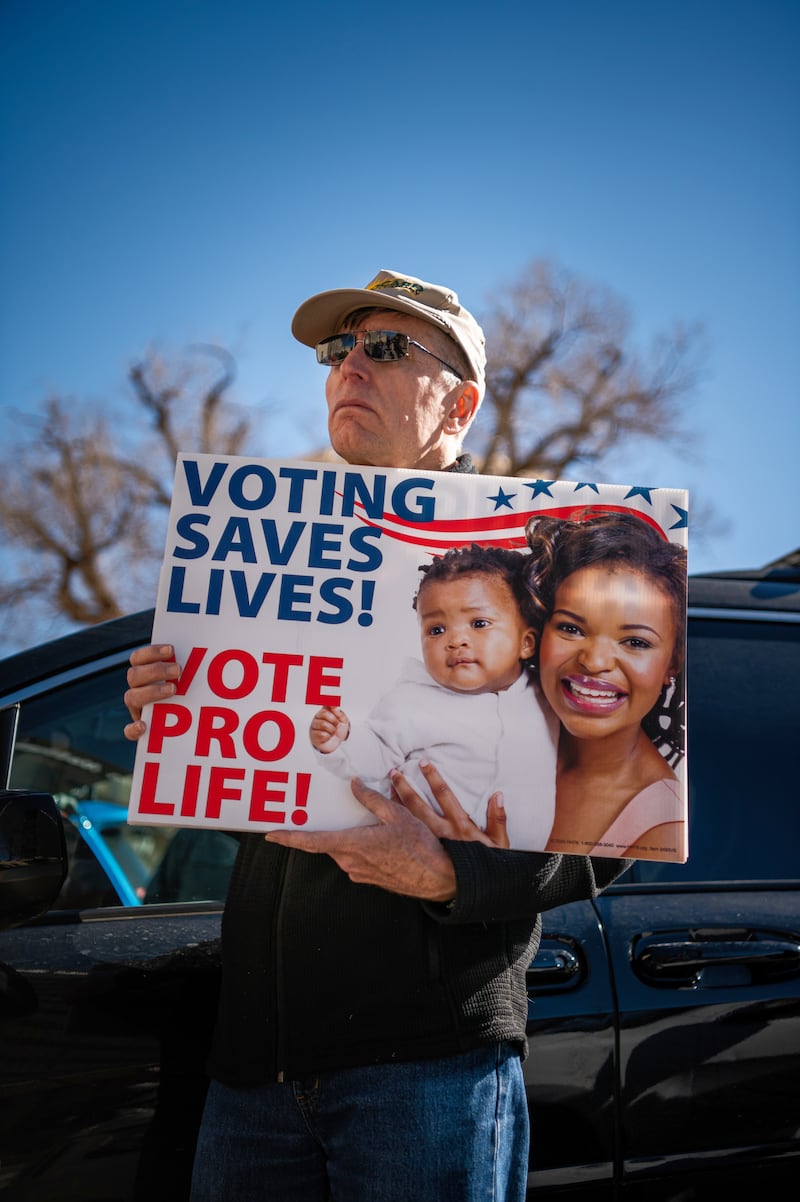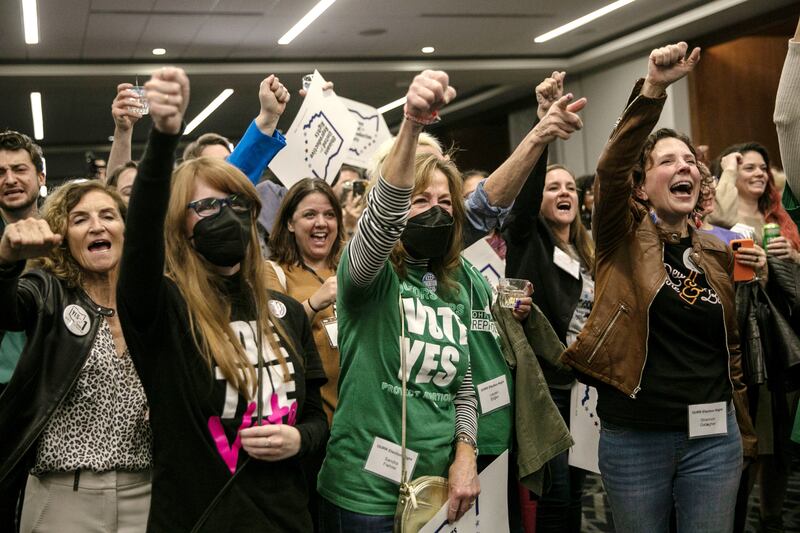As long as the US supreme court’s decision in Roe v Wade was the law of the land, conservatives complained that it had squelched the democratic process – that unelected men in black robes had handed down a national edict, upholding a constitutional right to abortion, rather than letting the American people sort out a consensus.
Celebrating Roe’s reversal in Dobbs v Jackson Women’s Health Organization, they declared that democracy would finally be allowed to take over and settle the question of abortion once and for all. “Now the American people get their voice back,” said Mitch McConnell, the Republican leader in the Senate. While the court in Roe had “inflamed debate and deepened division”, Justice Samuel Alito Jr wrote for the majority in Dobbs, “the people and their elected representatives” would reach the “national settlement” that had eluded the country for so long.
Eighteen months later, the American people are indeed using their voices, but not in the way anti-abortion advocates had hoped. In a steady march of ballot measures, even in conservative states such as Ohio, they have codified a right to abortion and rejected attempts to restrict it. Polls show increasing support for abortion rights in all 50 states, with majorities in nearly all states – even deep-red states – saying that abortion should be legal in all or most cases.
The entire dynamic of the debate has shifted: Democrats who once dreaded speaking the word abortion are now running on it, while Republicans struggle to define what exceptions they would allow to bans on the procedure, and former president Donald Trump now says overturning Roe was a mistake.
RM Block
And yet a “national settlement” seems more elusive than ever. One reason is simply American federalism, which allows states to set their own standards when there is no federal one. But a bigger reason is that Republicans around the country – the same people, in many cases, who once complained about Roe blocking the democratic process and imposing a one-size-fits-all rule on abortion nationwide – have turned much of their energy to keeping the issue away from voters.

Republican-controlled legislatures, shocked by the results of ballot measures that put the question of abortion directly to the people, are trying to make those measures harder to pass and even abolish them as an option. The issue is now in a different set of courts, in the states, where anti-abortion groups have searched out like-minded judges in an attempt to take abortion pills off the market.
In December, the supreme court – the black robes who were supposed to have put themselves out of the business of deciding abortion – agreed to hear a bid by President Joe Biden’s administration to preserve broad access to the abortion pill, setting up another major ruling on reproductive rights set to come in a presidential election year.
And some of the same Republicans who once argued that abortion should be settled by the will of the people in the states now argue that what is needed is for Congress to pass a uniform federal law.
Few people predicted how much abortion would define the elections of 2022; now it is the defining issue for 2024. But anyone hoping for democracy to resolve the debate will need to wait far longer than that. If the goal of the Dobbs decision was to let the will of the people decide the question of abortion, the question now is whether, in much of the US, the people’s opinions will be allowed to count.

Abortion-rights groups always said the country would become a patchwork of laws if Roe went away, and they have been proved correct. But so far, it’s not the patchwork anyone expected.
In some cases, the will of the people has protected abortion access. After voters affirmed a right to abortion in state constitutions in Kansas and Ohio, women in those states can get abortions well into the second trimester. In Michigan, a similar ballot measure led to a newly Democratic legislature enshrining Roe. And in purple Virginia, Republican governor Glenn Youngkin tried to get voters to give his party control of the legislature by campaigning on a promise to pass what he pitched as a consensus bill allowing abortion until 15 weeks. Voters rejected the bid and elected a legislature that now stands to join others in sponsoring a ballot measure to codify a constitutional right to abortion.
Voters in Pennsylvania and Wisconsin, too, came out to elect state supreme court justices who support abortion rights, even when abortion was not explicitly on the ballot. In Wisconsin, doctors had stopped performing abortions immediately after Roe fell for fear of running afoul of an 1849 ban, but the justices’ election gave Planned Parenthood enough confidence to reopen its clinics there.
Even Republican voters in red states are increasingly supportive of abortion rights, but their elected representatives show little interest in changing the law to reflect that.
In July, Christine Matthews, a Republican pollster, surveyed people in nine states where abortion is banned except to save the life of the pregnant woman and found that few knew the specifics of their law, but when they were told, the majority said they supported adding exceptions. The sentiment was highest in Texas, which banned abortion nine months before Roe fell, through a civilian-enforced law, which suggests that the more people know and see, the more they want to liberalise the laws.

More recently, another polling firm, PerryUndem, tested two similar ballot measures to see which found more support: One would establish an individual right to reproductive freedom, including the right to make “all decisions” on abortion; the other would establish that right but allow the state to regulate abortion after viability, unless the procedure was “medically necessary”. The version without any gestational restriction polled better.
Tresa Undem, one of the firm’s founders, was so surprised by the result that she asked her staff to quadruple-check the numbers, then conducted another poll and follow-up interviews to ask voters why they responded the way they did. Those polls found that respondents who had heard stories about women with pregnancy complications being forced to travel out of state for abortions were overwhelmingly likely to support a ballot measure – that included 57 per cent of Republicans.
Even 46 per cent of voters who said abortion should be illegal in most cases were likely to support a ballot measure establishing a right to abortion if they had heard these stories. And over and over, voters explained their preference by saying they did not want the government involved in deciding who gets an abortion.
But the potential for ballot measures is limited; fewer than 10 states that ban abortion also allow citizen-sponsored ballot measures. And in those states, anti-abortion groups and lawmakers are leaning hard into trying to keep the measures from making it on to the ballot. Abortion-rights groups in Missouri have spent nine months in court fighting the state’s Republican officials over their attempts to have the language on the ballot say that a yes vote would allow “dangerous and unregulated abortion until birth”.
In Arizona and South Dakota, anti-abortion groups that once saw ballot measures as their preferred instrument are running “decline to sign” campaigns against abortion-rights groups seeking signatures on ballot petitions. After Ohio voters decisively established a right to abortion in the state constitution in November, Rick Santorum, a former Pennsylvania senator and longtime anti-abortion crusader, expressed relief that not many states allowed ballot measures, “because pure democracies are not the way to run a country”.
Victories for abortion-rights groups on ballot measures haven’t necessarily resulted in changes to the law or opened up access to abortion. In Kentucky, even as voters rejected a ballot measure attempting to say there was no right to abortion, then re-elected a Democratic governor who campaigned on his support for abortion rights, a court has upheld a nearly total ban on abortion passed by the Republican legislature.
Is it complex? Is there a lot of grey? Yes
— Undem
So even as voters in Kentucky turn out to sound a lot like voters in California on the ballot questions, Americans will be living in two different countries on abortion. In one state, it is a crime that strips doctors of their licenses and sends them to prison for 99 years; next door, it is not only legal but publicly funded.
There are hints of a possible democratic consensus in the way many voters in conservative states have explained their support for ballot measures enshrining abortion rights. Those voters do not talk about abortion in the way pollsters and advocates have for five decades – as a debate between moral absolutes. After 18 months of stories about women denied care or pushed to the brink of death before they can get an abortion, more and more voters who might still describe themselves as “pro-life” or say they would not choose an abortion for themselves also say they do not want to stop someone who needs an abortion from getting one.
Undem said she has watched support for abortion increase in her focus groups since about 2017, after Trump’s election and the women’s marches that followed. For too long, she said, pollsters had described abortion as a deeply divisive issue. In fact, she said, voters were not divided if the question they were asked was who should decide whether to have an abortion: seven in 10 will say the person who is pregnant. The same percentage say they do not struggle with their views.

I just didn’t want to waste a lot of time on something we didn’t think would happen
— Richard Briggs
“Is it complex? Is there a lot of grey? Yes,” Undem said. “That’s why they don’t want politicians making their decisions.”
Even as Republican legislatures are doing everything they can to block more moderating public opinion from finding a voice in the law, there are some cracks in the wall.
In Tennessee, for instance, Richard Briggs, a Republican state senator and heart surgeon, went along in 2019 when the legislature passed a ban on abortion starting at conception because he assumed that Roe was firmly in place, so the law would never go into effect. “I just didn’t want to waste a lot of time on something we didn’t think would happen,” he said.
Last year, after that ban took effect, he polled high-frequency voters in his district in and around Knoxville and found remarkable support for some legalised abortion among all but about 20 per cent – and the results looked the same whether the respondents identified as “Trump Republicans” or “traditional Republicans”. He filed legislation earlier this year seeking exceptions for women facing serious medical emergencies, and in cases of rape, incest or severe foetal anomalies. He couldn’t get the package past a critical committee, after the state Right to Life group revoked its endorsement of him and threatened to do the same to any lawmaker who backed his bill.
“I don’t think we’re listening to the Republican voting public,” Briggs said. He now plans to introduce the legislation in steps over the next several years, beginning next year with a bill he calls the “Right to Have Children” act, which would allow women to have an abortion in cases of “medically futile pregnancies” or when they face conditions that can limit their future ability to have a child.
He expects a difficult road, though: Right now, he said, his Republican colleagues were more afraid of primary challenges from anti-abortion groups than they were of voters in their safe districts.
Republican voters are not showing an inclination to make abortion the deciding factor in their vote: While Democrats say abortion is more likely to drive their votes post-Dobbs, Republicans say it is less so. Republicans who support abortion rights probably aren’t going to vote against their party if they still agree with it on taxes. The American tradition of straight-ticket voting endures.
For the law to reflect what voters want, Briggs said, “what needs to happen is for some people to lose elections”. – This article originally appeared in The New York Times.

















